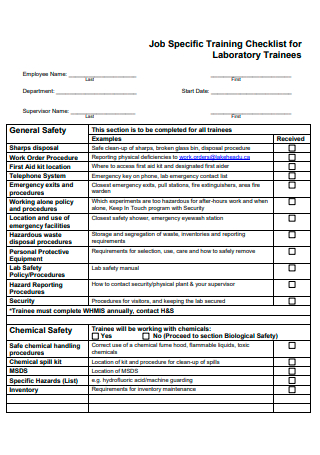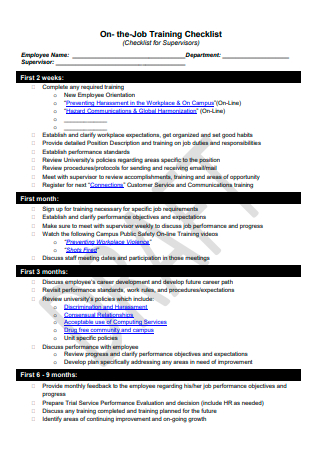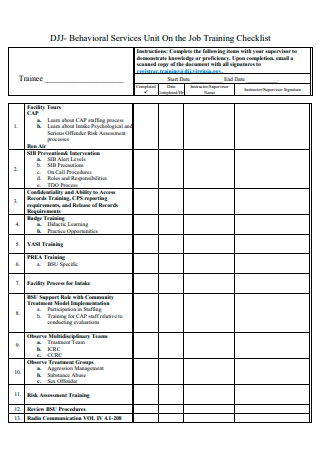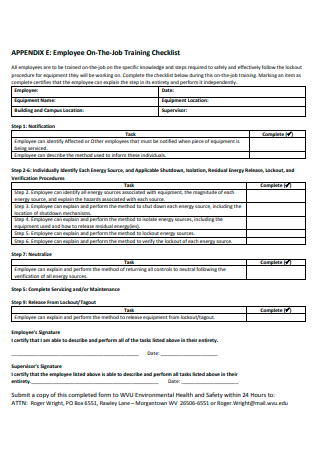5+ Sample Job Training Checklist
-

Job Specific Training Checklist
download now -

Employee Job Orientation and Training Checklist
download now -

On the Job Training Checklist
download now -

Job Aid Training Checklist
download now -

Behavioral Services Unit On the Job Training Checklist
download now -

Employee On The Job Training Checklist
download now
FREE Job Training Checklist s to Download
5+ Sample Job Training Checklist
What Is a Job Training Checklist?
Types of Training
Steps to an Efficient Job Training Plan
How to Make a Job Training Checklist
FAQs
Why is a training checklist important?
What makes a good training session?
How long should training last?
What Is a Job Training Checklist?
A checklist is essentially a knowledge management process that aids an organization in avoiding the costly trap of reinventing the wheel. It also guarantees that new workers are treated fairly and are given all of the knowledge they need to succeed in their new responsibilities. Only with a proper checklist in place can an employee training plan be successfully implemented. When training new users on enterprise applications, a job training checklist will outline the specific goals, needs, strategic plan, and curriculum to be addressed. Viewing the job training checklist template provided in this article will give you an idea of how it is structured.
Types of Training
There are several types of training that can be used to engage an employee. These types are typically used throughout the training onboarding process, including orientation, in-house, coaching and mentoring, and external training. The sort of training used is determined by the number of training resources available, the kind of company, and the prominence the company takes on training. Keep in mind that all kinds of training, no matter which you may have implemented as part of your program, will be most effective with a training evaluation.
Steps to an Efficient Job Training Plan
Training, learning, and growth in the workplace are critical for every firm. Whether it is to satisfy regulatory standards in a regulated business, to develop future leaders, or to engage and inspire staff in order to enhance retention. Staff training is required regardless of motive, but designing a successful employee training program may be difficult. Identifying training opportunities, creating effective training programs, marketing training, and encouraging participation may all be difficult tasks. Fortunately, this curated list will help you to specialize in staff training and development.
How to Make a Job Training Checklist
The checklist should include both standard organizational information and special elements relevant to the new employee’s function. However, there are some common topics that should be mentioned. Many of these are things that can be communicated through e-Learning or mobile learning. A sample job training checklist has been made available for your convenience and so you won’t have to worry about a concrete job training checklist format.
1. Present Company Background
The first step you will be doing is to introduce the company the new employees are welcomed into. You may have mentioned a bit of information but it is during this process that you can expound on the company history and Mission Statement. Make sure to include the company timeline and key achievements. Include a copy of your organizational chart, as well as extensive descriptions of department structures and duties, and identify where the new recruit fits inside the chart. Allow enough time for the new recruit to ask questions.
2. Discuss Company Policies and Regulations
Human resource concerns like absenteeism, holiday policy, complaints procedures, performance evaluations, and so on are all reflected. While this is most likely included in an employee handbook, it is critical that a new employee reads and acknowledges this book. This may all be controlled using an eLearning application, allowing questions to be asked while the employee takes their time reviewing and understanding the information. Describe the workplace rules such as the use of pantries, work hours, and breaks. Also, clarify the type of absences each employee is entitled to and whether they can be counted for sick or vacation leave.
3. Elaborate on the Inclusions and Benefits
Healthcare and stock option programs may be complicated. Explain your benefits in simple words throughout this training. Clarify whatever steps workers must do in order to use their benefits packages. Answer any queries they may have. Get signed copies of contracts if necessary. Present all alternatives for life and health insurance policies, ensure that new recruits understand the terms, and give documentation that clarifies the terms in detail. You may also explain how to make use of all accessible training and advancement benefits, such as education funds.
4. Introduce Specific Roles
Hiring managers utilize this training to explain team structure and duties, set expectations for success, and provide new recruits with relevant tools and resources. You must be able to outline the new hire’s responsibilities, such as what they would do on a normal day at work. Also, show the new recruit job-specific tools and give a list of useful sites for finding solutions to frequently asked queries. Display and explain reports that track the team’s key performance indicators (KPIs), offer business objectives relating to the new recruit’s job and team, and describe the responsibilities of different team members and how the new hire will collaborate with them.
5. IT Setup and Training
IT staff should assist new employees in configuring their computer stations and ensuring that all systems are operational. They should also train new employees on data privacy, malware detection, and proper software and hardware usage. Ensure that new recruits have access to the tools and instructions required to utilize hardware and software. Check to see if new workers have created business accounts, such as email, and offer assistance as required.
6. Follow Up on the Training Plan
Evaluation is an essential part of any kind of training, no matter what role they will be assumed under a certain department of the company. This section of the checklist may be found on a separate page or at the most-bottom entirely. As this is meant to check whether or not the training was sufficient and successfully understood by the new face of the company.
FAQs
Why is a training checklist important?
It makes new workers feel at ease and alleviates any concern they may have; it lets a new employee grasp the company in terms of mission, work structure, expectations, laws, and regulations; and it socializes the new employee with the current personnel, including management. Having a consistent checklist guarantees that no critical part of the company or the individual’s work is neglected, whether the majority of the training is on the job, in an e-Learning environment, or in a hybrid approach.
What makes a good training session?
The most excellent training affects learning by engaging all of the senses. Show and utilize teaching ideas to increase comprehension and knowledge of the subject. Frequent testing is required. When students or employees are aware that they will be tested, they are more likely to pay attention to the subject. All coaches should include the following aspects in their training sessions: session introduction, warm-up, skill and fitness exercises, cool-down, and review. Participants should be given an outline of the training session before it begins.
How long should training last?
It’s difficult to strike a balance between quality and running time. If your short course is too low on content, it will have little impact; on the other hand, too crammed courses will put your audience’s attention span to the test. On-the-job training might be anywhere from a few days to several weeks, depending on the responsibilities required. Often, new workers begin by observing other employees before progressing to complete activities under supervision.
Training enables students to develop new information and skills. The most successful training also assists learners in applying this information in the workplace, a process called learning transfer. The efficacy of your training relates to how well it facilitates learning and learning transfer. Instilling crucial and relevant information for your new employee will be important as they will use it as they continue working. This is why utilizing the available work training checklist template is important to save time and effort.
